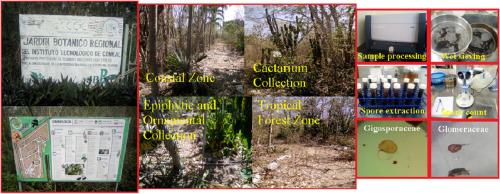与墨西哥热带植物园有关的丛枝菌根相互作用
IF 4.8
Q1 MICROBIOLOGY
引用次数: 0
摘要
植物园作为植被保护区,已成为有益土壤微生物群的重要宝库,主要作为农业用途的微生物接种体来源。灌木状菌根真菌(AMF)是热带土壤的重要遗传资源,在农业生产中具有很大的潜力,一般用作接种介质,为作物提供更好的产量、生产力和生理反应。这项研究探讨了植物园中的 AMF 存在情况,植物园由四个区域组成:仙人掌收藏区、附生植物和观赏植物收藏区、热带雨林区和沿海地区。每个区域都由代表其生态系统的植物组成。研究采用随机系统模式,每个地点采集 9 个深度为 20 厘米的样本。对土壤进行了物理化学特征描述。通过湿筛和 60% 蔗糖离心提取 AMF 孢子。孢子按分类群进行鉴定。结果表明,在研究地区共鉴定出 379 个 AMF 孢子。热带森林地区的孢子发生率最高,共提取了 161 个(53.67±5.51)孢子,其次是沿海地区和仙人掌采集区,分别提取了 78 个(26.00±9.64)和 73 个(24.33±4.73)孢子。该研究确定了两个类群,即团扇科(Glomeraceae)和巨孢科(Gigasporaceae)。团扇科类群也被认为是本次研究中最具代表性的类群(丰度和频率最高)。总之,植物园通过其外部结构(植物组成)和管理可被视为重要的生态系统库和可行微生物遗传物质的来源,用于生物勘探有益的土壤基因资源(根瘤菌和内生菌),以用于现代农业和可持续食品生产系统。本文章由计算机程序翻译,如有差异,请以英文原文为准。

Arbuscular mycorrhizal interaction associated with a botanical garden in the tropics of Mexico
Botanical gardens, areas for vegetation conservation, have become important reservoirs of beneficial soil microbiota, mainly as a source of microbial inoculum for agricultural purposes. Shrubby mycorrhizal fungi (AMF), an important genetic resource of tropical soils, have a high potential for agricultural production, generally used as inoculant medium that provides better yield, productivity and physiological response to crops. This research study explores the presence of AMF in a botanical garden, composed of four areas: cactarium collection, epiphytes and ornamental collection, tropical forest area and coastal zone. Each area is composed of plants representative of its ecosystem. For the study, a random systematic model was used, with nine samples per site at a depth of 20 cm. A physicochemical characterization of the soils was developed. The extraction of AMF spores was carried out by wet sieving and centrifugation in 60% sucrose. The spores were identified by taxon. The results indicate a total of 379 AMF spores identified in the study area. The highest spore incidence was recorded in the tropical forest area with a total of 161 (53.67±5.51) spores extracted, followed by the coastal zone and cactus collection area with 78 (26.00±9.64) and 73 (24.33±4.73) spores in total. In the study two taxa were identified, Glomeraceae and Gigasporaceae. The taxon Glomeraceae is also considered to be the most representative (highest abundance and frequency) of the study. In conclusion, botanical gardens, by their extructure (plant composition) and management can be taken into account as important ecosystems reservoirs and source of viable microbial genetic material for the bioprospecting of beneficial soil genotic resources (rhizophiles and endophylls) for use in modern agriculture and sustainable food production systems.
求助全文
通过发布文献求助,成功后即可免费获取论文全文。
去求助
来源期刊

Current Research in Microbial Sciences
Immunology and Microbiology-Immunology and Microbiology (miscellaneous)
CiteScore
7.90
自引率
0.00%
发文量
81
审稿时长
66 days
 求助内容:
求助内容: 应助结果提醒方式:
应助结果提醒方式:


